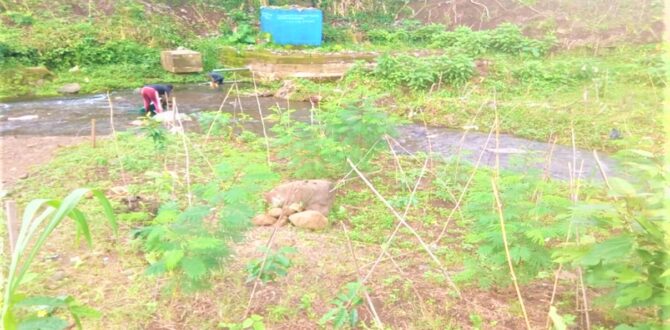The efforts of Ecological Balance to clean recharge and conserve underground water of the Bulu water catchment in Buea is yielding success. Out of the 3000 tree seedlings and cuttings planted in March 2020, 2700 of them are growing well giving a survival rate of over 88%.

This statistics is generated from monthly data collected during monitoring field visits to the site under the auspices of Head of the Reforestation Unit of Ecological Balance, Njiafu Benardin. While collecting the monthly data, the monitoring team noted visible signs of clean recharge. “We have seen all types of crabs. This is an indicator of a clean fresh water ecosystem,” Mr. Njiafu opines.
Few months after the tree planting exercise, community members are already witnessing a mark difference. “Since the trees were planted, I have noted that the catchment has remained ‘unusually’ clean” Chief Mafani John, traditional ruler of Kombo village attests. He added that “I have not seen any project that planted and maintained trees. Most of the trees are surviving and the environment is gradually becoming green. This initiative should be replicated all over Buea. I have taken upon myself to educate my fellow chiefs on this project”.
Conserving the Bulu water catchment, according to the Executive Director of Ecological Balance, Ms. Limbi Blessing Tata, is a unique contribution to saving humanity, especially given that many neighbouring communities depend on it for drinking water.
The Bulu water catchment is the main source of portable water to the Kombo, Bolifamba and Dibanda communities of the Buea Municipality.
With funds and mentorship from the SUGi Project and Afforestt, Ecological Balance had in March 2020 planted some 12 tree species at the Bulu water catchment in Buea, South West Region of Cameroon. These trees species included; Prunus africana (pygeum), Entandrophragma angolensis (big leaf mahogany), Dacryodes edulis (African plum), Cordia platythyrsa (drummer stick) , Persea americana (avocado), Artocarpus heterophyllus (jack fruit), Mangifera indica (mango) , Erythrina spp, Jatropha curcas, Leuceana leucocephala, Acacia angiutissimma, and Pachira aquatica (money tree).
It is hoped that these trees will also allow for the gathering of non-timber forest products (spices, fruits, honey, nuts etc), serve as habitat for biodiversity and contribute in mitigating global climate change.
By Ndimuh B. Shancho








ive checked this cool site a few times now and i have to say that i find it quite good actually. continue doing what youre doing! 😉